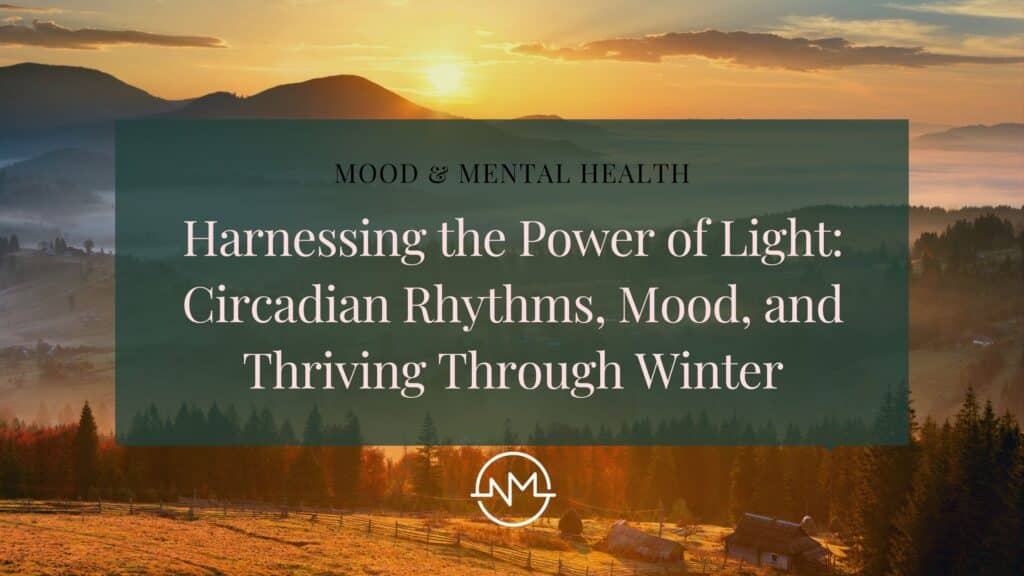As the days grow shorter and sunlight becomes scarce, many of us start to feel a shift — not just in the air, but in our energy, mood, and even our health. Understanding the science of circadian rhythms and the profound role of natural light can empower us to make simple, effective changes that help us “hack” our natural biological rhythms to feel better all year round.
Let’s explore the biological mechanisms behind this, and evidence-based strategies you can use to support your mind and body through winter.
The Science: What is the Circadian Rhythm?
Your circadian rhythm is a 24-hour internal clock that governs virtually every biological process — from hormone secretion and sleep-wake cycles to digestion, immune function, and even cognitive performance.
At the heart of this clock is a group of neurons called the suprachiasmatic nucleus (SCN), located in the hypothalamus. The SCN responds directly to light signals from the retina, synchronizing your body with the external environment.
Key players regulated by circadian rhythms include:
-
Melatonin: Promotes sleep; rises when it’s dark.
-
Cortisol: Energizes the body; peaks in the morning light.
-
Serotonin: A precursor to melatonin; influenced heavily by exposure to daylight.
Without enough natural light — especially during winter — this delicate system becomes disrupted, contributing to fatigue, low mood, poor concentration, and even immune dysregulation.
Quick Fact: Studies show that inadequate light exposure can delay melatonin onset, disrupt sleep, and worsen symptoms of depression.
Sunlight and Mood: Why Light is Nature’s Antidepressant

Exposure to full-spectrum natural sunlight boosts mood through several mechanisms:
-
Increases serotonin production: Bright light stimulates serotonin synthesis in the brain.
-
Regulates melatonin: Proper light exposure ensures melatonin is secreted at the right time (evening), supporting restful sleep.
-
Enhances vitamin D synthesis: While its mood benefits are complex, vitamin D insufficiency has been linked with depressive symptoms.
In fact, seasonal affective disorder (SAD) — a type of depression that occurs predominantly in winter — is strongly associated with reduced light exposure and circadian disruption.
Clinical Insight: Bright light therapy is considered a first-line treatment for SAD and has been shown to outperform placebo.
Nutrition, Naturopathy, and Winter Resilience

A naturopathic approach to managing the effects of winter incorporates light, nutrition, and lifestyle medicine to realign the body’s rhythms.
Here are some key strategies:
1. Maximise Morning Light Exposure
-
Get outside within the first hour of waking, even on cloudy days. Natural light intensity is still far greater than indoor lighting.
-
If outdoor exposure is limited, consider using a full-spectrum light therapy box for 20–30 minutes.
2. Prioritise Circadian-Friendly Nutrition
-
Breakfast timing matters: Eating a high-protein breakfast within 1–2 hours of waking helps anchor cortisol rhythms and stabilize blood glucose.
-
Tryptophan-rich foods (precursor to serotonin): Include oats, eggs, turkey, pumpkin seeds, and cottage cheese.
-
Support melatonin production in the evening with foods rich in magnesium and B6, such as almonds, leafy greens, and bananas.
3. Supplement Wisely (with Professional Guidance)
-
Vitamin D3: Deficiency is common in winter; optimal serum levels are associated with better mood and immune resilience.
-
Magnesium: Supports sleep, neurotransmitter balance, and stress resilience.
-
Omega-3 fatty acids (EPA/DHA): Shown to have anti-inflammatory and mood-stabilizing effects, especially in depression.
4. Optimise Sleep Hygiene
-
Dim lights 1–2 hours before bed to stimulate melatonin.
-
Avoid blue light exposure from screens in the evening (or use blue light-blocking glasses).
-
Maintain a consistent sleep-wake schedule, even on weekends.
5. Embrace Movement
-
Outdoor exercise is the ultimate circadian and mood enhancer: it combines light exposure, endorphin release, and rhythm entrainment.
-
Aim for at least 20–30 minutes daily, prioritising daylight hours if possible.
Winter doesn’t have to mean feeling low, tired, or disconnected. By understanding your body’s innate rhythms and supporting them with light, nutrition, and lifestyle medicine, you can stay energised, balanced, and resilient throughout the colder months.

